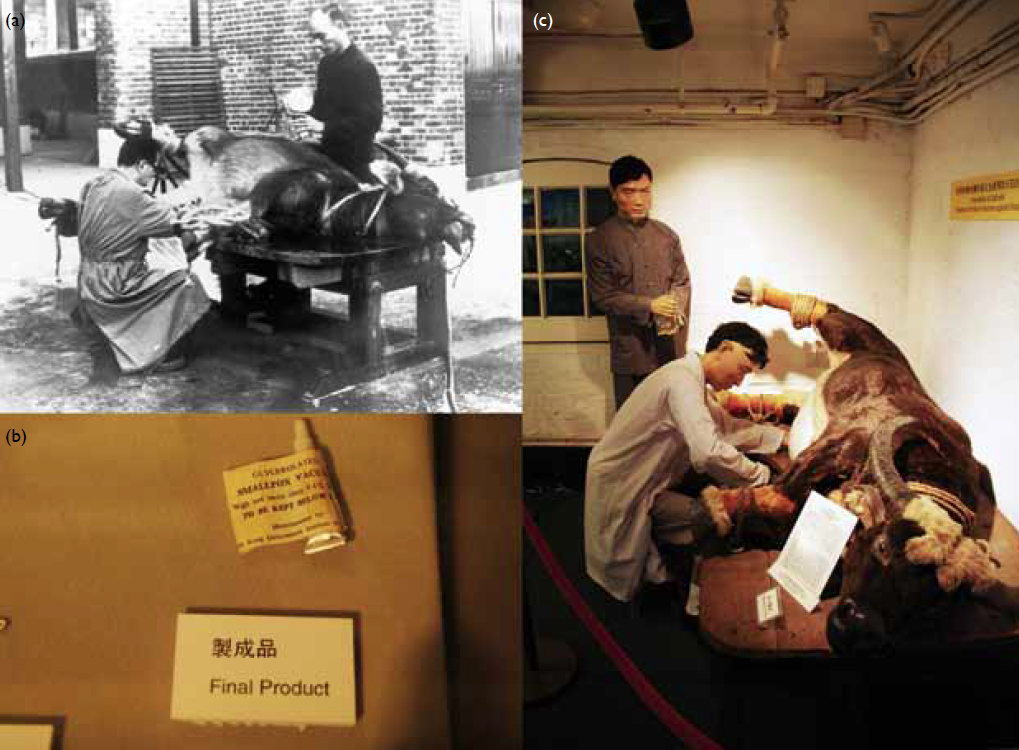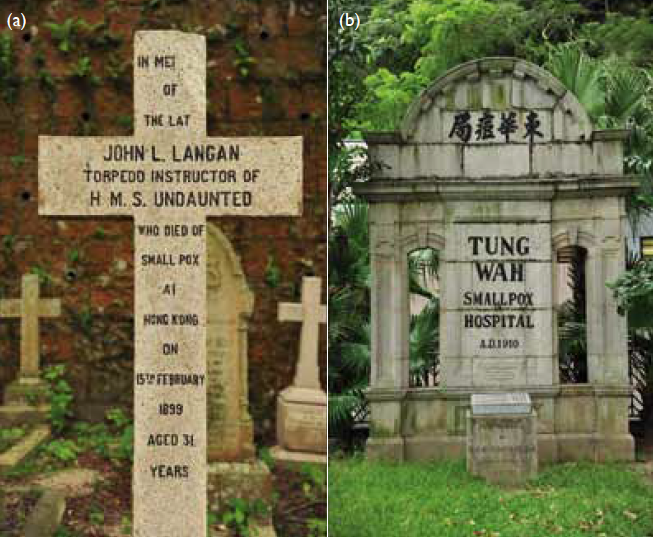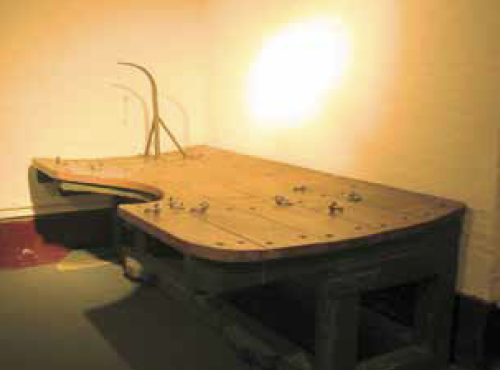© Hong Kong Academy of Medicine. CC BY-NC-ND 4.0
REMINISCENCE: ARTEFACTS FROM THE HONG KONG MUSEUM OF MEDICAL SCIENCES
The calf vaccinating table
Samson SY Wong, FRCPath, FHKCPath
Member, Education and Research Committee, Hong Kong Museum of Medical Sciences Society
This has to be the highlight of any visit to the Hong
Kong Museum of Medical Sciences—mannequins
of two men and a buffalo calf on a table, the calf
vaccinating table (Figs 1 and 2c). The existing calf
table was transferred to the Hong Kong Museum of
Medical Sciences by the Department of Health in
1996. The table was manufactured locally and was in
use from the mid-1940s to the 1970s. A description
on the equipment that accompanied the transfer is
as follows1 (Fig 2a):
In the process of smallpox vaccine production, a buffalo calf was led to stand alongside the teak table top which has been hinged vertically. The calf was fastened manually on the table. The holes and grooves on the table top were devices to drain off the cleansing water. Once the animal was immobile [sic], the table top was hinged upwards with the calf lying on it horizontally. The calf’s right leg was then fastened to the curved, iron retort stand so that its belly was completely exposed and ready for shaving, cleansing, disinfecting and eventually vaccinating by scarification.
In the process of smallpox vaccine production, a buffalo calf was led to stand alongside the teak table top which has been hinged vertically. The calf was fastened manually on the table. The holes and grooves on the table top were devices to drain off the cleansing water. Once the animal was immobile [sic], the table top was hinged upwards with the calf lying on it horizontally. The calf’s right leg was then fastened to the curved, iron retort stand so that its belly was completely exposed and ready for shaving, cleansing, disinfecting and eventually vaccinating by scarification.

Figure 2. (a) Staff of the old Pathological Institute vaccinating a buffalo calf. From Hong Kong Museum of Medical Sciences Archives, donated to the Hong Kong Museum of Medical Sciences Society by staff of the former Pathological Institute. (b) Finished product of the smallpox vaccine manufactured by the Bacteriological Institute. (c) Present-day demonstration of smallpox vaccine production on the calf vaccinating table
The table is the most recognisable relic of a
unique function of the old Bacteriological Institute,
viz vaccine production. The Bacteriological Institute
produced smallpox vaccine from the early 1900s until
1973.2 Records indicate that when the Government
Bacteriologist took over the role of Director of the
Government Vaccine Institute in October 1902,
4616 tubes of smallpox vaccine had been produced
from 23 calves in that year.3 The vaccines produced
were not only used locally (hospitals and private
doctors), but also delivered to the naval and military
authorities, as well as Canton and other neighbouring
ports.3 The annual quantity of vaccines produced
varied. For example, following a local epidemic of
smallpox, 137 646 tubes of vaccine were issued in
1923.4 It is interesting to note that the initial uptake
of smallpox vaccination in the local population was
rather lukewarm, but it increased after 1928 as a
result of greater community engagement by various
non-governmental organisations.5
Smallpox was one of the deadliest infectious
diseases of mankind until 1977. Hong Kong was free
from the disease for 2 years before being declared
smallpox-free in July 1979.6 Vaccination played a
crucial role in global eradication of the disease.
The story of cowpox vaccination by Edward Jenner
in 1796 marked the earliest systematic use of
human vaccination for the prevention of infectious
diseases. The first-generation smallpox vaccines
were originally produced by inoculating animals
with infectious materials by scarification, followed
by harvesting of the vesicle fluid (the so-called
‘lymph’) from the animals and subsequent storage
of the vaccine as a freeze-dried product (Fig 2b).
Calves were most commonly used for this purpose,
although donkeys and horses could also be used.7
Buffalo calves were kept in the animal house of the
Bacteriological Institute for this purpose. Similar
tables were used in other countries in the past for
vaccinating calves and harvesting of lymph.8
The form of smallpox encountered in Hong
Kong was mostly variola major, the more severe
form of the disease with an overall case-fatality ratio
of around 30%.9 Although smallpox was a statutory
notifiable disease even in the early days of colonial
Hong Kong, it was estimated that as many as two
thirds of cases were not notified because many local
Chinese considered it a relatively minor condition
that was managed by herbalists.5 Dr Uttley, a local
medical officer, reported a crude death rate from
smallpox of 0.46 per 1000 population (range, 0.01-2.27 per 1000) for the years 1897 to 1936.5 Mortality of smallpox among the local Chinese was highest
among children, with 53% of fatal cases occurring
in children under 3 years of age, and 72% occurring
in children under 5. In contrast, in contemporary
England and Wales, smallpox mortality was highest
among adults aged 25 to 45 years. The discrepancy
was believed to be due to better childhood smallpox
immunisation coverage in England and Wales with
subsequent waning of immunity during adulthood.5
Although smallpox had been a scourge of mankind
for centuries, few relics of the history of smallpox
remain in Hong Kong. Today, a tomb of a young
naval officer who died from smallpox in the late
19th century in Hong Kong can still be found
(Fig 3a). Another indication of the public health
significance of the disease in Hong Kong was the
Tung Wah Smallpox Hospital, of which only the
arch and foundation stone remain (Fig 3b). It was
built originally to house plague patients in 1902 and
converted to become one of the several early health
care facilities dedicated to the care of smallpox
patients. It was later changed to an infectious disease
hospital prior to its demolition.6

Figure 3. Local relics of the history of smallpox in Hong Kong
(a) Grave of a local smallpox victim in the 19th century located in the Hong Kong Cemetery. Inscriptions on the headstone of the grave read, “In memory of the late John L. Langan, torpedo instructor of HMS Undaunted, who died of smallpox at Hong Kong on 15th February 1899, aged 31 years.” (b) Remains of the Tung Wah Smallpox Hospital, A.D. 1910, currently located in Sai Ning Street, Kennedy Town. Foundation stone laid by Sir Henry Arthur Blake, G.C.M.G., Governor of the Colony of Hong Kong, on 18 November 1901. Inscription on the top of the foundation stone reads, “The arch and the foundation stone were once part of the Tung Wah Smallpox Hospital, completed in 1910, not far from this spot. In 1938, the building became the Government Infectious Disease Hospital, and was demolished after the Second World War.”
Although smallpox has been eradicated for 40
years, lessons from the virus and the disease remain
relevant to us today. Routine vaccination against
smallpox is no longer necessary but vaccination is
still implemented in certain special populations, such
as military personnel in some countries or laboratory
workers who handle poxviruses.10 11 12 13 Research on
smallpox and related vaccines remains active in the
ever-present threat of bioterrorism and the need
for protection against other poxvirus infections of
humans, such as monkeypox. Newer second-, third-,
and fourth-generation smallpox vaccines have been
developed using cell cultures of live-attenuated viruses
or recombinant subunits, although only very few
of these newer-generation vaccines (eg ACAM200,
Sanofi Pasteur) have been licensed for human use.14 15 The vaccinia virus and its derivatives, as well as other
poxviruses, have also found new life in medicine as
they may serve as vaccine vectors against a number
of infectious diseases and even for treatment of
cancers because of their oncolytic properties.14 16 Last but not the least, as the only human infectious
disease that has ever been eradicated through human
interventions, the story of smallpox remains an
invaluable legacy in public health and other disease
eradication programmes.17
References
1. Lau CH, Department of Health. Letter to the Hong Kong Museum of Medical Sciences on the transferral of old
equipment. 9 January 1996. Data on file in the Hong Kong Museum of Medical Sciences.
2. The Bacteriological Institute and its contributions to Hong Kong. In: Hong Kong Museum of Medical Sciences
Society. Plague, SARS and the Story of Medicine in Hong Kong. Hong Kong: Hong Kong University Press; 2006:
147-224.
3. Hunter W. Report of the Government Bacteriologist, for the year 1902. Hong Kong: Government Public Mortuary;
1903.
4. Minett EP. Report of the Bacteriological Institute, 1923. Hong Kong Government; 1924.
5. Uttley KH. The death rate and epidemiology of smallpox in Hongkong. Trans R Soc Trop Med Hyg 1938;31:635-46. Crossref
6. History of infectious disease in Hong Kong: a story of discovery and challenge. In: Hong Kong Museum of Medical
Sciences Society. Plague, SARS and the Story of Medicine in Hong Kong. Hong Kong: Hong Kong University Press;
2006: 17-74.
7. Parrino J, Graham BS. Smallpox vaccines: Past, present, and future. J Allergy Clin Immunol 2006;118:1320-6. Crossref
8. Lymph from calf 2. The Historical Medical Library of The College of Physicians of Philadelphia. Available from:
http://www.historyofvaccines.org/content/lymph-calf-2. Accessed 21 Nov 2016.
9. Moore ZS, Seward JF, Lane JM. Smallpox. Lancet 2006;367:425-35. Crossref
10. Artenstein AW. Vaccines for military use. Vaccine 2009;27 Suppl 4:D16-22. Crossref
11. Department of Health, United Kingdom. Guidelines for smallpox response and management in the post-eradication
era, Version 2. Available from: http://webarchive.nationalarchives.gov.uk/20110907164128/http://www.dh.gov.uk/prod_consum_dh/groups/dh_digitalassets/@dh/@en/documents/digitalasset/dh_4070832.pdf. Accessed 21 Nov
2016.
12. Public Health England. Smallpox and vaccinia: the Green Book, chapter 29. 2013. Available from: https://www.gov.uk/government/uploads/system/uploads/attachment_data/file/148501/Green-Book-Chapter-29-dh_063660.pdf.
Accessed 21 Nov 2016.
13. Petersen BW, Harms TJ, Reynolds MG, Harrison LH. Use of vaccinia virus smallpox vaccine in laboratory and
health care personnel at risk for occupational exposure to orthopoxviruses — Recommendations of the Advisory
Committee on Immunization Practices (ACIP), 2015. MMWR Morb Mortal Wkly Rep 2016;65:257-62. Crossref
14. Verardi PH, Titong A, Hagen CJ. A vaccinia virus renaissance: new vaccine and immunotherapeutic uses after
smallpox eradication. Hum Vaccin Immunother 2012;8:961-70. Crossref
15. Nalca A, Zumbrun EE. ACAM2000: the new smallpox vaccine for United States Strategic National Stockpile. Drug
Des Devel Ther 2010;4:71-9. Crossref
16. Kim M. Replicating poxviruses for human cancer therapy. J Microbiol 2015;53:209-18. Crossref
17. Tomori O. From smallpox eradication to the future of global health: innovations, application and lessons for future
eradication and control initiatives. Vaccine 2011;29 Suppl 4:D145-8. Crossref


